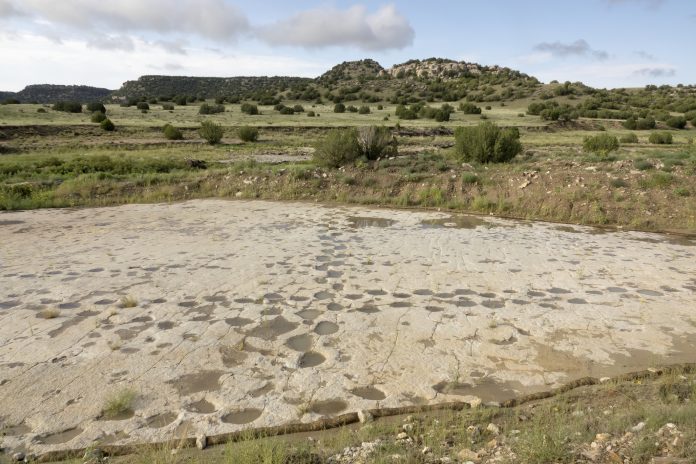The study of rock art in Namibia’s Doro Nawas mountains uncovers diverse motifs, detailed animal track insights, and cultural preferences, notably the unique direction of zebra tracks
In Namibia, ancient rock surfaces are adorned with numerous Stone Age depictions, encompassing animals and human footprints and the tracks left by animals. These animal tracks have received limited attention until now, as researchers needed more expertise for their interpretation.
Collaborating closely with animal tracking specialists from the Nyae Nyae Conservancy in Tsumkwe, Namibia, archaeologists from University of Erlangen-Nuremberg (FAU) and the University of Cologne have undertaken a thorough investigation of the engraved animal tracks found on six rock surfaces.
This collaborative effort has yielded detailed insights into the species, age, gender, limbs, body side, trackway, and relative direction of these tracks.
Stone Age hunters and gatherers
Located in the Doro Nawas mountains within the Namib Desert of northwest Central Namibia, the landscape is characterised by limited vegetation, with trees and shrubs primarily found along small, dry riverbeds.
Despite this arid environment, several permanent waterholes have led to an unusually diverse array of wildlife in the region. Here, one can encounter various animals, such as springboks, giraffes, elephants, lions, and leopards, all freely traversing the area.
Remarkably, this area remains untouched by human habitation or exploitation in the present day.
However, the historical context tells a different story. Abundant evidence of rock art depicting animals, along with human footprints and animal tracks, attests to the fact that this region was once home to Stone Age hunters and gatherers.
Reevaluating animal tracks and their value to historical research
Until now, archaeologists have primarily focused on identifying the species of animals depicted in rock art, often grouping animal tracks with abstract symbols. This oversight prompted PD Dr. Andreas Pastoors from the Institute for Prehistory and Protohistory at FAU to emphasise the untapped value of traces and tracks as sources of information.
Until now, archaeologists have primarily focused on identifying the species of animals depicted in rock art
Driven by this insight, he, his FAU colleagues Prof. Dr. Thorsten Uthmeier and Dr. Tilman Lenssen-Erz from the African Research Institute at the University of Cologne, embarked on an innovative research project. This initiative aimed to merge conventional Western archaeological science with indigenous knowledge.
The project’s inception traces back to 2013 when San tracking experts from Namibia deciphered human footprints on the floors of caves in France adorned with Ice Age rock art.
Building on this collaboration, the researchers, joined by Namibian tracking experts Tsamgao Ciqae, Ui Kxunta, and Thui Thao from the Nyae Nyae Conservancy in Namibia, established a base camp in the Doro Nawas mountains. Over approximately one week, they examined six rock surfaces featuring a significant concentration of human footprints and animal tracks.
The examined rock surfaces are situated on the periphery of a region resembling a crater, with an approximate diameter of one kilometre, within the Doro Nawas mountains. “At the upper edge there are large boulders with flat surfaces which people in the Stone Age decorated with rock art,” explains Pastoors.
The rock art displays a diverse array of motifs, encompassing a wide spectrum of subjects, from human footprints to depictions of individuals and various animals, including elephants, giraffes, rhinoceroses, and ostriches.
“These images are easily recognisable by Western archaeologists,” says Pastoors.
In addition, these artworks also portray animal tracks, which, up until this point, were typically grouped with abstract symbols and not given individual attention. “Seen from the perspective of Western art history, researchers are unable to recognise anything in these images, as they are lacking the relevant expertise.”
Tracks that reveal discernible patterns
The recently published study challenges the previous approach to rock art analysis. Tsamgao Ciqae, Ui Kxunta, and Thui Thao made remarkable discoveries in rock art. They examined 513 images and could discern specific details in over 90 percent.
These details included the species, age range, gender, specific body parts, body side, and the direction of animal tracks or human footprints. Intriguingly, the animal tracks revealed a more diverse range of species than the images of animals depicted in profiles in nearby rock art from the same era.
Furthermore, the analyses reveal discernible patterns that appear to be influenced by cultural preferences. One notable example is the relative direction of the individual animal tracks, which the tracking experts deciphered from the images.
As a result, most tracks pointed upward, roughly towards 12 o’clock, while only a few pointed downward, towards 6 o’clock. Interestingly, the zebra tracks stood out as an exception, as they were depicted moving in various directions.











